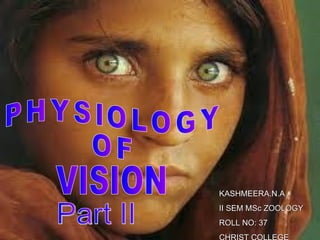
PHYSIOLOGY OF VISION,Part -II
- 1. KASHMEERA.N.A II SEM MSc ZOOLOGY ROLL NO: 37
- 2. The Eye as a Cam a er • The eye is optically equivalent to the usual photographic camera. • It has a lens system, • a variable aperture system (the pupil), • and a retina that corresponds to the film.
- 3. F o r mat i o n o f i mag e o n re t i na
- 4. F o u r b as i c p r o c e s s ar e i n vo l ve d i n t h e f o r mat i o n o f an i mag e o n r e t i n a Refraction of light rays Accommodation of lens Constriction of pupil Convergence
- 5. Ref r ac t i on of Li g ht Ray s • When light rays traveling through a transparent substance pass into a second transparent substance with a different density, they bend at the junction between the two substances. This bending is called refraction.
- 6. The lens system of the eye is composed of four refractive interfaces: (1) the interface between air and the anterior surface of the cornea, (2) the interface between the posterior surface of the cornea and the aqueous humor, (3) the interface between the aqueous humor and the anterior surface of the lens of the eye, (4) the interface between the posterior surface of the lens and the vitreous humor.
- 7. Ac c om odat i on of l ens m Convex lens will refract incoming light rays toward each other, so that they eventually intersect. Concave lens causes light rays to refract away from each other.
- 8. The lens of the eye is convex on both its anterior and posterior surfaces Its focusing power increases as its curvature becomes greater. When the eye is focusing on a close object, the lens becomes more curved, causing greater refraction of the light rays. This increase in the curvature of the lens for near vision is called accommodation .
- 9. Ho w d o e s ac c o mmo d at i o n o c c u r ? viewing distant objects – the ciliary muscle of the ciliary body is relaxed – the lens is flatter [ because it is stretched in all directions by zonular fibers. ] viewing a close object,- the ciliary muscle contracts – releases tension on the lens and zonular fibers. – the lens becomes more spherical (more convex) – which increases its focusing power and causes greater convergence of the light rays. Parasympathetic fibers of the oculomotor (III) nerve innervate the ciliary muscle of the ciliary body and, therefore, mediate the process of accommodation
- 11. Cons t r i c t i on of pupi l The pupil of the human eye can become as small as about 1.5 mm and as large as 8 mm in diameter. .The constriction of the pupil is a narrowing of the diameter of the hole through which light enters the eye due to the contraction of the circular muscles of the iris. This autonomic reflex occurs simultaneously with accommodation and prevents light rays from entering the eye through the periphery of the lens. Light rays entering at the periphery would not be brought to focus on the retina and would result in blurred vision. The greatest possible depth of focus occurs when the pupil is extremely small. - with a very small aperture, almost all the rays pass through the center of the lens, and the central most rays are always in focus.
- 12. Conver genc e In humans, both eyes focus on only one set of objects—a characteristic called binocular vision. B.V allows the perception of depth and an appreciation of the 3 D nature of objects. B.V occurs when light rays from an object strike corresponding points on the two retinas. When we stare at a distant object, the incoming light rays are aimed directly at both pupils and are refracted to identical spots on the retinas of both eyes. As we move closer to an object, however, the eyes must rotate medially for the light rays from the object to strike the same points on both retinas.
- 13. • The term convergence refers to this medial movement of the two eyeballs so that both are directed toward the object being viewed. • The nearer the object, the greater the degree of convergence • The coordinated action of the extrinsic eye muscles brings about convergence. convergence
- 14. F o r mat i o n o f i mag e o n r e t i n a • The image on retina is inverted and reversed with respect to the object. • However mind perceives objects in the upright position because the brain is trained to consider an inverted image as the normal.
- 15. PHOTOCHEMI S TRY OF VI S I ON
- 16. Rhodops i n- r et i nal vi s ual c yc l e i n t he r od
- 17. PHOTOCHEMI S TRY OF COL OUR VI S I ON
- 18. • photochemicals in cones are similar to rhodopsin (scotopsin + retinal) • cones contain photopsin + retinal • 3 different types of photochemicals are present in cones, their light absorption spectra are different cone pigment wavelength of peak absorption (nm) blue-sensitive pigment 445 green-sensitive pigment 535 red-sensitive pigment 570 • rods have peak sensitivity at 505 nm
- 19. • Human eye can see any colour due to a combination of red, green and blue monochromatic light in different proportions.
- 20. EL ECTROPHYS I OL OGY OF VI S I ON
